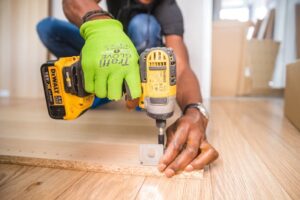
Photo by Get Lost Mike on <a href="https://www.pexels.com/photo/green-grass-lawn-near-white-and-brown-house-under-blue-sky-6267516/" rel="nofollow">Pexels.com</a>
An infestation of mold may seriously endanger the health of building inhabitants and result in structural damage to commercial facilities. A healthy and secure workplace for workers and visitors depends on prompt and efficient mold removal. You may follow along as this step-by-step guide takes you through the commercial mold removal procedure.
Step 1: Determining the Amount of Mold Contamination
The evaluation of the afflicted area is the initial stage in commercial mold remediation. Certified mold remediation experts will thoroughly examine the property to determine the level of mold contamination, the moisture source, and any underlying issues that may have contributed to mold formation. This thorough evaluation is essential because it gives a thorough knowledge of the mold problem, enabling the creation of an efficient and focused treatment plan.
Step 2: Preventing the Spread of Mold Spores
Strict containment procedures are used during the cleanup process to stop the accidental spread of mold spores. Professional cleanup professionals use plastic sheeting to carefully seal off the afflicted area and use specialized equipment to produce negative air pressure. By creating a negative air pressure environment, it is possible to keep mold spores in the afflicted region and prevent them from spreading to other areas of the structure. It’s crucial to have strong containment measures in place to reduce cross-contamination and safeguard tenants’ health and safety.
Step 3: Eliminating Mold Growth
Mold eradication starts when an adequate containment system has been developed. The mold eradication techniques used are determined by how bad the infestation is. It could be necessary to carefully remove and properly dispose of non-porous substances highly polluted by industry standards. On the other hand, porous materials may frequently be cleaned and treated using the proper cleaners. Professionals in mold remediation use specialized tools like HEPA vacuum cleaners and air cleaners to collect mold spores and stop them from spreading, ensuring that mold is completely removed from the harmed surfaces and places.
Step 4: Air Filtration
Optimizing indoor pollution levels is critical in commercial mold treatment. High-efficiency particle air (HEPA) filters are used in air cleaners and HVAC systems throughout the cleanup process. These HEPA filters collect and trap mold spores in the air, thereby cleansing them. Continuous air filtration using HEPA filters helps to remove any leftover mold spores, resulting in healthier and more pure air for building occupants.
Step 5: Drying and Dehumidification
It is critical to address the underlying moisture sources to avoid mold growth. Any moisture-related issues must be addressed after the obvious mold has been removed. Commercial-grade dehumidifiers properly dry the damaged area, lowering humidity levels and removing excess moisture that promotes mold growth. Repairing leaks, enhancing ventilation systems, and taking preventive efforts to minimize moisture penetration are all priorities for remediation specialists. The likelihood of mold return is considerably reduced by eliminating all moisture sources.
Step 6: Cleaning and Disinfection
Following mold treatment, a sanitized and safe environment must be created through meticulous cleaning and disinfection. Companies specializing in mold remediation use specialist antimicrobial treatments to clean and disinfect surfaces in the afflicted area. These treatments efficiently eliminate any mold spores that are still present and prevent their recurrence. Surfaces, including furniture, flooring, and walls, are thoroughly cleaned and disinfected to remove mold toxins and make the space safe for residents.
Step 7: Looking for a Professional If you Can’t DIY
Hiring a skilled commercial mold remediation company with experience managing commercial buildings is essential when dealing with a mold issue in a business setting. You may have peace of mind knowing that the mold issue in your business property will be efficiently treated by industry best practices and safeguarding the well-being and security of your staff and tenants by engaging a skilled commercial mold remediation firm.
Step 8: Prevention
Implementing preventative actions is crucial to reducing the danger of future mold growth. This entails handling any lingering moisture problems inside the structure by speedily fixing leaks or enhancing drainage systems. To prevent excessive moisture buildup, optimum ventilation and humidity levels must be maintained. To locate and eliminate any possible mold sources early on, routine inspections are advised.
Conclusion
Commercial mold remediation calls for knowledge, competence, and adherence to standards set by the sector. Using a reputable mold remediation firm with licensed professionals can reduce health hazards and stop additional damage to the business property while also ensuring that the process is carried out appropriately.


